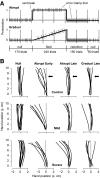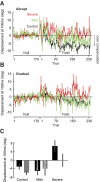Size of error affects cerebellar contributions to motor learning
- PMID: 20164398
- PMCID: PMC2853280
- DOI: 10.1152/jn.00822.2009
Size of error affects cerebellar contributions to motor learning
Abstract
Small errors may affect the process of learning in a fundamentally different way than large errors. For example, adapting reaching movements in response to a small perturbation produces generalization patterns that are different from large perturbations. Are distinct neural mechanisms engaged in response to large versus small errors? Here, we examined the motor learning process in patients with severe degeneration of the cerebellum. Consistent with earlier reports, we found that the patients were profoundly impaired in adapting their motor commands during reaching movements in response to large, sudden perturbations. However, when the same magnitude perturbation was imposed gradually over many trials, the patients showed marked improvements, uncovering a latent ability to learn from errors. On sudden removal of the perturbation, the patients exhibited aftereffects that persisted much longer than did those in healthy controls. That is, despite cerebellar damage, the brain maintained the ability to learn from small errors and the motor memory that resulted from this learning was strongly resistant to change. Of note was the fact that on completion of learning, the motor output of the cerebellar patients remained distinct from healthy controls in terms of its temporal characteristics. Therefore cerebellar degeneration impaired the ability to learn from large-magnitude errors, but had a lesser impact on learning from small errors. The neural basis of motor learning in response to small and large errors appears to be distinct.
Figures






References
-
- Baizer JS, Kralj-Hans I, Glickstein M. Cerebellar lesions and prism adaptation in macaque monkeys. J Neurophysiol 81: 1960–1965, 1999 - PubMed
-
- Boyden ES, Katoh A, Pyle JL, Chatila TA, Tsien RW, Raymond JL. Selective engagement of plasticity mechanisms for motor memory storage. Neuron 51: 823–834, 2006 - PubMed
-
- Criscimagna-Hemminger SE, Donchin O, Gazzaniga MS, Shadmehr R. Learned dynamics of reaching movements generalize from dominant to nondominant arm. J Neurophysiol 89: 168–176, 2003 - PubMed
-
- Hatada Y, Miall RC, Rossetti Y. Two waves of a long-lasting aftereffect of prism adaptation measured over 7 days. Exp Brain Res 169: 417–426, 2006 - PubMed
Publication types
MeSH terms
Grants and funding
LinkOut - more resources
Full Text Sources

